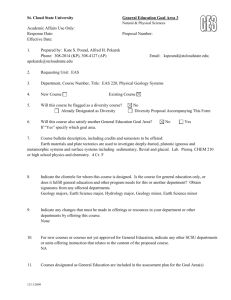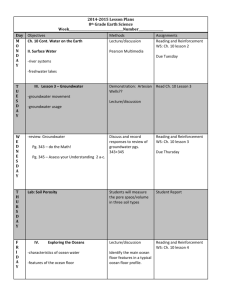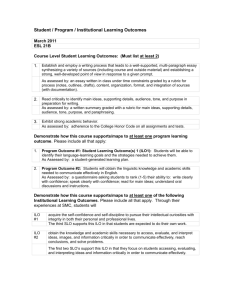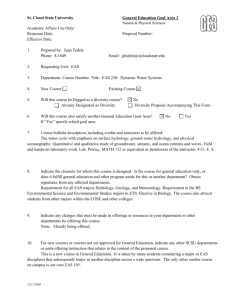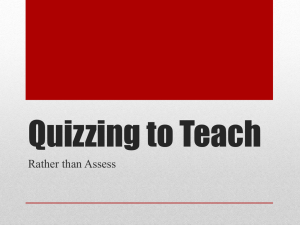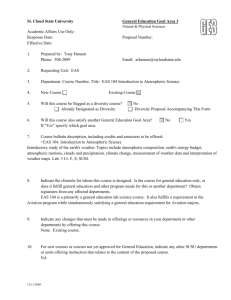GE-10-293 EAS 105 The Water Environment
advertisement
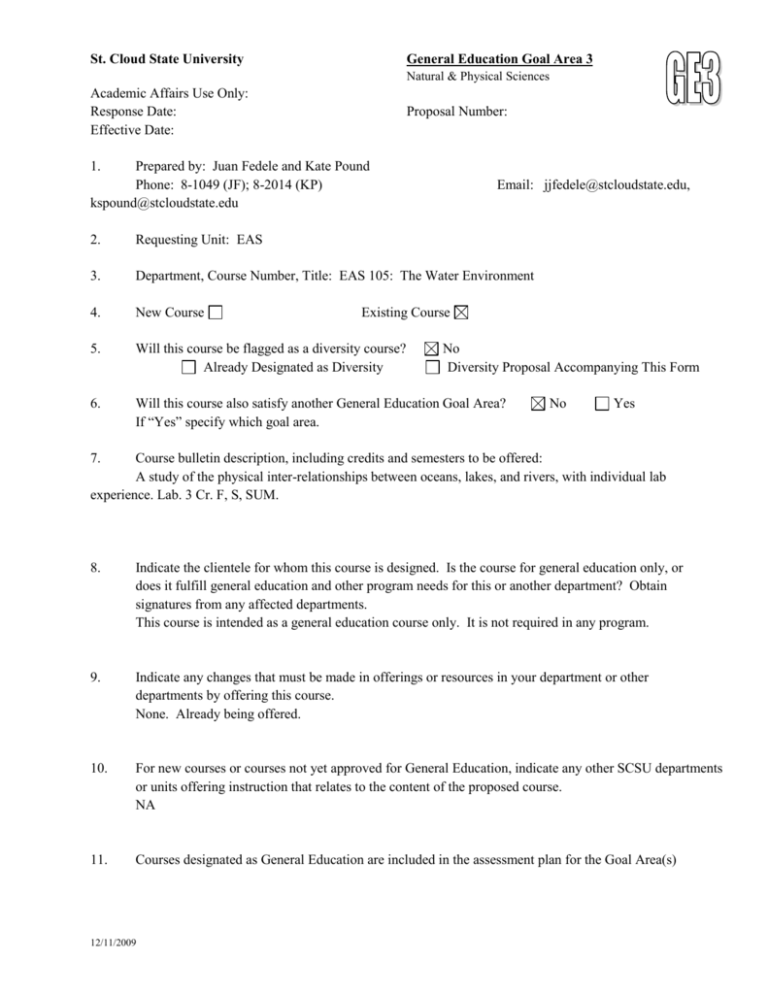
St. Cloud State University General Education Goal Area 3 Natural & Physical Sciences Academic Affairs Use Only: Response Date: Effective Date: Proposal Number: 1. Prepared by: Juan Fedele and Kate Pound Phone: 8-1049 (JF); 8-2014 (KP) kspound@stcloudstate.edu Email: jjfedele@stcloudstate.edu, 2. Requesting Unit: EAS 3. Department, Course Number, Title: EAS 105: The Water Environment 4. New Course 5. Will this course be flagged as a diversity course? Already Designated as Diversity 6. Will this course also satisfy another General Education Goal Area? If “Yes” specify which goal area. Existing Course No Diversity Proposal Accompanying This Form No Yes 7. Course bulletin description, including credits and semesters to be offered: A study of the physical inter-relationships between oceans, lakes, and rivers, with individual lab experience. Lab. 3 Cr. F, S, SUM. 8. Indicate the clientele for whom this course is designed. Is the course for general education only, or does it fulfill general education and other program needs for this or another department? Obtain signatures from any affected departments. This course is intended as a general education course only. It is not required in any program. 9. Indicate any changes that must be made in offerings or resources in your department or other departments by offering this course. None. Already being offered. 10. For new courses or courses not yet approved for General Education, indicate any other SCSU departments or units offering instruction that relates to the content of the proposed course. NA 11. Courses designated as General Education are included in the assessment plan for the Goal Area(s) 12/11/2009 for which they are approved. Courses for which assessment is not included in the annual GE assessment report for two years will be removed from the General Education Program. The Requesting Unit understands and recognizes the above conditions. 13. Provide a concise explanation of how the following goal is a “significant focus” of the proposed course. Goal Area 3: Natural & Physical Sciences Explore scientific knowledge of the natural world. Understand the central concepts and principles of science; experience the process of scientific inquiry; comprehend science as a human endeavor and understand the impact of science on individuals and on society. EAS 105 incorporates an introduction to the scientific method and exercises on its use and application. Students learn about the physics and chemistry of natural water, and complete qualitative and quantitative evaluations of hydrologic processes in, on, and above the earth's surface. EAS 105 also studies water as a human resource, a hazard, and an area of environmental concern. 14. In order for a course to be designated as fulfilling Goal Area 3, it must address at least 5 of the 6 student learning outcomes (SLOs) below. Check the SLOs below that are focused on in the proposed general education course. 1. Demonstrate knowledge of concepts, principles, and theories in the physical or natural sciences. 2. Make observations and collect data, design and carry out experiments or other types of scientific investigations. 3. Formulate research questions and testable hypotheses, analyze and interpret data, draw inferences and conclusions, and identify further questions for investigation. 4. Demonstrate awareness of the interdependent relationships of basic science, applied science, mathematics, and technology. 5. Recognize the human nature of the scientific enterprise, including the importance of curiosity, creativity, and imagination; the dual nature of scientific knowledge as changeable and durable; and the impact of a scientist's personal identity on the scientific process. 6. Evaluate societal issues from a science perspective, question the evidence presented, and make informed judgments about these issues. 15. Discuss how each Student Learning Outcome checked above is achieved in this course. (Note: Although descriptions of typical assignments or types of assignments may be part of this discussion, it is not appropriate to submit copies of actual assignments.) SLO 1: Demonstrate knowledge of concepts, principles, and theories in the physical or natural sciences. (a) Students will apply basic principles of physics such as Newton’s laws, circular motion, and the Coriolis effect, to explain the global circulation in the atmosphere and the surface and deep ocean currents. This will be assessed in a D2L Quiz, a Lab, and in class question cards. (b) Students will apply basic principles of chemistry (oxidation, reduction, and solubility) to explain and predict problems of water contamination and pollution. This will be assessed in aD2L quiz and 1 lab (groundwater) (c) Students will use the mechanics of surface (rivers) and subsurface (groundwater) water motion and apply them to predict and mitigate problems such as flooding, pollution and preservation of water resources. This will be assessed in a D2L Quiz, a Lab, and in class question cards. 12/11/2009 SLO 2: Make observations and collect data, design and carry out experiments or other types of scientific investigations. (a) Students will construct and interpret graphs and plots using real-world data, and will develop basic graph analysis skills (rate of change, contour line analysis) for use in interpreting real world hydrological data. This will be assessed in a Lab, and in class question cards. (b) Students will access NOAA or USGS data sets, and selected and evaluate data on ocean temperature, salinity distributions, sea-floor sediments, wave height, ocean currents, river discharge and stages, distribution of aquifers and groundwater flow. Students will use these data to answer questions, test hypotheses and identify further questions. This will be assessed in a D2L Quiz or a Lab. SLO 3: Formulate research questions and testable hypotheses, analyze and interpret data, draw inferences and conclusions, and identify further questions for investigation. (a) Students will use available data to test theories and hypotheses related to the development of hurricanes, magnitude and impact of flooding, coastal erosion, surface and groundwater contamination. This will be assessed in a D2L Quiz, a Lab, and in-class questions. (b) Students will use water-well data to predict groundwater flow motion and direction, the movement of contamination plumes, and design mitigation plans. This will be assessed in a Lab. SLO 4: Demonstrate awareness of the interdependent relationships of basic science, applied science, mathematics, and technology. (a) Students will apply basic calculations to evaluate water budgets (on different hydrological systems, which include, for example, river discharge, water supply, groundwater flow rates, wave motion, and energy budgets). (b) Students will apply knowledge of basic physical principles to the problems of measuring physical parameters such as stream discharge and groundwater flow rates. Students will identify the limitations and applicability of their results and predictions. This will be assessed in a D2L Quiz, a Lab, and in class question cards. SLO 5: Recognize the human nature of the scientific enterprise, including the importance of curiosity, creativity, and imagination; the dual nature of scientific knowledge as changeable and durable; and the impact of a scientist's personal identity on the scientific process. (a) Students will be able to explain how the scientific method was used by individual scientists through history to build the unifying theory of Plate Tectonics which shaped ocean basins, and impacts ocean circulation and weather patterns. This will be assessed in a D2L Quiz and in class question cards. SLO 6: Evaluate societal issues from a science perspective, question the evidence presented, and make informed judgments about these issues. (a) Students will be able to recognize the importance of understanding how hydrological systems work, and how that knowledge can be positively used to develop policies and planning at different societal levels, with the goal 12/11/2009 of preserving and sustaining water resources.This will be assessed in a D2L Quiz, a Lab, and in class question cards. (b) Students will be able to understand and explain the impact of human activities on rivers, aquifers, and other ecosystems such as wetlands and lakes. This will be assessed in a Lab. (c) Students will be able to use quantitative data and knowledge of global phenomena to explain the impacts of climate change in hydrological and oceanographic systems; i.e. the role that plate tectonics plays in controlling ocean circulation and climate. This will be assessed in a D2L Quiz, a Lab, and in class question cards. 16. Courses satisfying Goal Area 3: Natural & Physical Sciences must have either a “traditional lab course or a lab-like experience”. Check which of these apply and supply a brief explanation of how the course is either a laboratory course or incorporates a “lab-like experience”. Course includes: Laboratory Lab-like experience The following quote from a National Research Council subcommittee report may help to identify a course with a laboratory. ”Laboratory experiences provide opportunities for students to interact directly with the material world (or with data drawn from the material world), using the tools, data collection techniques, models, and theories of science.” America's Lab Report: Investigations in High School Science (Free Executive Summary) http://www.nap.edu/catalog/11311.html This course makes use of real-world Earth Science data sets (stream flow and discharge, ocean-floor sediments, meteorological data). Students are either provided with the data, or are directed to it in its original format. Students use the data to answer questions or investigate topics. These resources include monitoring stations for acquistion of real-time data on ocean currents and seawater composition, stream flow, atmospheric composition and conditions, and groundwater levels and water quality. These resources are used in Labs, and in class presentations and discussions. 17. List or attach the Course Outline (adequately described and including percentage of time to be allocated to each topic). Curriculum Committees may request additional information. Topics larger than 20% need to be broken down further. Indicate in your course outline where the Student Learning Outcomes checked above are being met. Topical Coverage Module I: Introduction, Basic Physical Concepts, Oceanography Science And The Scientific Method Chemical And Physical Properties Of Water Principles From Physics—Forces, Motion, Circular motion Using And Analyzing Scientific Data Global Circulation--Atmospheric and Oceanic Surface and Deep Oceanic Currents, Ocean Basins Deep And Shallow Water Waves Module II: Water in the Atmosphere Humidity: Water vapor in the air Basis of cloud formation, stability of air and lift processes Precipitation, forms of precipitaion and measurement Weather patterns and severe storms Global Warming—Theory, Facts, and Myths Module III: Water in the Continents Water Distribution and Movement on Earth--Water Cycle 12/11/2009 % Time 35 5 5 5 5 5 5 5 30 4 8 8 8 2 35 5 Assessed SLO # 1a 4a,b 1a 1a 2a,b; 5a 2b 3a 4a,b;6b Water Supply Rivers-Generalities; Measurements; Flooding Groundwater – Movement and Aquifers Glaciers – Glaciology, Physics of Glacial Ice Ice Ages and Impacts on Modern Landscapes 12/11/2009 3 10 10 5 2 4c 1c, 2a,b;6a,b 1b,c; 2a,b; 3b 4a,b 6a,c St. Cloud State University General Education Transmittal Form Academic Affairs Use Only: Response Date: Effective Date: Proposal Number Department: Earth and Atmospheric Sciences Course or Course(s): EAS 105: The Water Environment Department or Unit Chair Signature Date Department forward to Academic Affairs for publication and electronically to Chair of General Education Committee, Chair of College Curriculum Committee, College Dean Recommendation of General Education Committee: Approve Remarks: Disapprove Chairperson Committee Signature Date Recommendation of University Curriculum Committee: Approve Remarks: Disapprove Chairperson Committee Signature Date Recommendation of Faculty Association: Approve Remarks: Disapprove FA Senate Signature Date Action of Academic Vice President: Approve Disapprove Signature Entered in Curriculum Data File 12/11/2009 Remarks: Date
